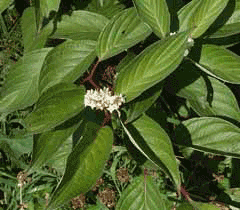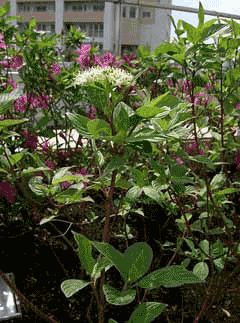 |
|
http://commons.wikimedia.org/wiki/User:Ies |
 |
| http://commons.wikimedia.org/wiki/User:KENPEI |
Translate this page:
Summary
Physical Characteristics

 Cornus alba is a SHRUB growing to 3 m (9ft) by 3 m (9ft) at a fast rate.
Cornus alba is a SHRUB growing to 3 m (9ft) by 3 m (9ft) at a fast rate.
See above for USDA hardiness. It is hardy to UK zone 3. It is in flower from June to July, and the seeds ripen from August to October. The species is hermaphrodite (has both male and female organs) and is pollinated by Insects.
Suitable for: light (sandy), medium (loamy) and heavy (clay) soils. Suitable pH: mildly acid, neutral and basic (mildly alkaline) soils. It can grow in semi-shade (light woodland) or no shade. It prefers moist or wet soil.
UK Hardiness Map
US Hardiness Map
Synonyms
Plant Habitats
Woodland Garden
Edible Uses
Edible Parts: Oil
Edible Uses: Oil
None known
References More on Edible Uses
Medicinal Uses
Plants For A Future can not take any responsibility for any adverse effects from the use of plants. Always seek advice from a professional before using a plant medicinally.
None known
References More on Medicinal Uses
The Bookshop: Edible Plant Books
Our Latest books on Perennial Plants For Food Forests and Permaculture Gardens in paperback or digital formats.

Edible Tropical Plants
Food Forest Plants for Hotter Conditions: 250+ Plants For Tropical Food Forests & Permaculture Gardens.
More

Edible Temperate Plants
Plants for Your Food Forest: 500 Plants for Temperate Food Forests & Permaculture Gardens.
More

More Books
PFAF have eight books available in paperback and digital formats. Browse the shop for more information.
Shop Now
Other Uses
Oil
The seeds contain 30% oil, which is used industrially[266].
Special Uses
References More on Other Uses
Cultivation details
An easily grown plant, it succeeds in any soil of good or moderate fertility[1]. Grows well in heavy clay soils and in dry soils. Succeeds in full sun or light shade[[188]. Succeeds in poorly drained soils and so is suitable for streamside plantings[200]. Plants are hardy to about -25°c[200]. A vigorous, fast-growing species, it is very ornamental, especially in the autumn and winterm with its fruit, autumn leaf colour and coloured stems[200]. For the best coloured stems, the plant should be cut back hard in the spring to about 5cm from the ground[200]. There are several named varieties, selected mainly for their variegated leaves or winter stem colour[11]. Plants in this genus are notably resistant to honey fungus[200].
References Carbon Farming Information and Carbon Sequestration Information
Temperature Converter
Type a value in the Celsius field to convert the value to Fahrenheit:
Fahrenheit:
The PFAF Bookshop
Plants For A Future have a number of books available in paperback and digital form. Book titles include Edible Plants, Edible Perennials, Edible Trees,Edible Shrubs, Woodland Gardening, and Temperate Food Forest Plants. Our new book is Food Forest Plants For Hotter Conditions (Tropical and Sub-Tropical).
Shop Now
Plant Propagation
Seed - best sown as soon as it is ripe in a cold frame or in an outdoors seedbed if there is sufficient seed[80, 113]. The seed must be separated from the fruit flesh since this contains germination inhibitors[80, 164]. Stored seed should be cold stratified for 3 - 4 months and sown as early as possible in the year[164]. Scarification may also help as may a period of warm stratification before the cold stratification[80, 164]. Germination, especially of stored seed, can be very slow, taking 18 months or more[164]. Prick out the seedlings of cold-frame sown seeds into individual pots as soon as they are large enough to handle and grow the plants on for their first winter in a greenhouse, planting out in the spring after the last expected frosts. Cuttings of half-ripe side shoots, July/August in a frame. Cuttings of mature wood of the current year's growth, taken with a heel if possible, autumn in a cold frame. High percentage[78]. Layering of new growth in June/July. Takes 9 months[78].
Other Names
If available other names are mentioned here
Native Range
TEMPERATE ASIA: Russian Federation (Altay, Buryatia, Chita, Gorno-Altay, Irkutsk, Kemerovskaja oblast, Krasnoyarsk, Kurganskaja oblast, Novosibirsk, Omsk, Tomsk, Tyumen, Tyva, Respublika, Yakutia-Sakha), Mongolia, Russian Federation (Habarovskij kraj, Primorye, Amur, Sakhalin), China (Gansu Sheng, Hainan Sheng, Hebei Sheng, Heilongjiang Sheng, Jiangsu Sheng, Jiangxi Sheng, Jilin Sheng, Liaoning Sheng, Nei Mongol Zizhiqu, Qinghai Sheng, Shaanxi Sheng, Shandong Sheng), Korea EUROPE: Russian Federation-European part (European part)
Weed Potential
Right plant wrong place. We are currently updating this section.
Please note that a plant may be invasive in one area but may not in your area so it's worth checking.
Conservation Status
IUCN Red List of Threatened Plants Status :

| Related Plants
|
| Latin Name | Common Name | Habit | Height | Hardiness | Growth | Soil | Shade | Moisture | Edible | Medicinal | Other |
| Cornus alternifolia | Green Osier, Alternateleaf dogwood, Alternate Leaf Dogwood, Golden Shadows Pagoda Dogwood, Green Osi | Shrub | 6.0 |
3-8
| F | LMH | N | DM | 0 | 2 | 2 |
| Cornus amomum | Silky Dogwood | Shrub | 3.0 |
4-8
| M | LMH | SN | M | 1 | 2 | 1 |
| Cornus asperifolia drummondii | Roughleaf Dogwood | Shrub | 4.0 |
5-9
| F | LMH | N | M | 0 | 0 | 3 |
| Cornus australis | | Shrub | 4.0 |
6-9
| | LMH | SN | M | 1 | 0 | 3 |
| Cornus canadensis | Creeping Dogwood, Bunchberry dogwood, Bunchberry | Perennial | 0.3 |
2-7
| F | LMH | SN | M | 4 | 2 | 2 |
| Cornus capitata | Bentham's Cornel | Tree | 12.0 |
7-10
| M | LMH | SN | M | 4 | 1 | 3 |
| Cornus chinensis | | Tree | 10.0 |
7-10
| | LMH | SN | M | 2 | 3 | |
| Cornus controversa | Giant Dogwood, Wedding Cake Tree, | Tree | 15.0 |
5-8
| F | LMH | SN | M | 2 | 1 | 2 |
| Cornus coreana | | Tree | 20.0 |
5-9
| | LMH | SN | M | 0 | 0 | 2 |
| Cornus elliptica | | Tree | 10.0 |
7-10
| M | LMH | SN | M | 4 | 1 | 2 |
| Cornus florida | Flowering Dogwood | Shrub | 6.0 |
5-9
| M | LMH | SN | M | 2 | 2 | 3 |
| Cornus hemsleyi | | Shrub | 4.0 |
-
| | LMH | SN | M | 0 | 0 | 2 |
| Cornus hongkongensis | | Shrub | 15.0 |
-
| | LMH | SN | M | 1 | 0 | 2 |
| Cornus iberica | | Shrub | 4.0 |
-
| | LMH | SN | M | 2 | 0 | 3 |
| Cornus kousa | Japanese Dogwood, Kousa dogwood, Chinese Dogwood, | Tree | 10.0 |
5-8
| S | LMH | SN | M | 5 | 0 | 2 |
| Cornus kousa chinensis | Japanese Dogwood | Tree | 10.0 |
5-8
| | LMH | SN | M | 5 | 0 | 2 |
| Cornus macrophylla | Large-Leaf Dogwood | Tree | 15.0 |
5-9
| | LMH | SN | M | 2 | 2 | 2 |
| Cornus mas | Cornelian Cherry, Cornelian Cherry Dogwood | Shrub | 5.0 |
4-8
| M | LMH | SN | M | 4 | 2 | 3 |
| Cornus monbeigii | | Shrub | 5.0 |
6-9
| | LMH | SN | M | 1 | 2 | 2 |
| Cornus multinervosa | | Tree | 8.0 |
-
| | LMH | SN | M | 2 | 0 | 2 |
| Cornus nuttallii | Mountain Dogwood, Pacific dogwood, Western Dogwood | Tree | 10.0 |
6-8
| M | LMH | SN | DM | 1 | 2 | 3 |
| Cornus oblonga | Oblong-Petal Dogwood | Tree | 6.0 |
8-11
| | LMH | SN | M | 0 | 3 | 2 |
| Cornus occidentalis | Western Dogwood | Shrub | 6.0 |
5-9
| | LMH | SN | M | 1 | 1 | |
| Cornus officinalis | Shan Zhu Yu, Asiatic dogwood, Japanese Cornel Dogwood | Shrub | 10.0 |
5-8
| M | LMH | SN | M | 4 | 3 | 0 |
| Cornus poliophylla | | Shrub | 4.0 |
6-9
| | LMH | SN | M | 1 | 2 | 2 |
| Cornus quinquenervis | | Shrub | 3.0 |
4-8
| | LMH | SN | M | 2 | 0 | |
| Cornus rugosa | Round-Leaved Dogwood | Shrub | 3.0 |
4-8
| | LMH | SN | DM | 0 | 1 | |
| Cornus sanguinea | Dogwood, Bloodtwig dogwood | Shrub | 3.0 |
4-8
| | LMH | SN | M | 2 | 1 | 3 |
| Cornus sericea | Red Osier Dogwood, Western dogwood | Shrub | 2.5 |
2-7
| F | LMH | SN | MWe | 2 | 2 | 4 |
|
|
Growth: S = slow M = medium F = fast. Soil: L = light (sandy) M = medium H = heavy (clay). pH: A = acid N = neutral B = basic (alkaline). Shade: F = full shade S = semi-shade N = no shade. Moisture: D = dry M = Moist We = wet Wa = water.
Now available:
Food Forest Plants for Mediterranean Conditions
350+ Perennial Plants For Mediterranean and Drier Food Forests and Permaculture Gardens.
[Paperback and eBook]
This is the third in Plants For A Future's series of plant guides for food forests tailored to
specific climate zones. Following volumes on temperate and tropical ecosystems, this book focuses
on species suited to Mediterranean conditions—regions with hot, dry summers and cool, wet winters,
often facing the added challenge of climate change.
Read More
Expert comment
Author
L.
Botanical References
11200266
Links / References
For a list of references used on this page please go here
Readers comment
| Add a comment |
|
If you have important information about this plant that may help other users please add a comment or link below. Only comments or links that are felt to be directly relevant to a plant will be included. If you think a comment/link or information contained on this page is inaccurate or misleading we would welcome your feedback at [email protected]. If you have questions about a plant please use the Forum on this website as we do not have the resources to answer questions ourselves.
* Please note: the comments by website users are not necessarily those held by PFAF and may give misleading or inaccurate information.
To leave a comment please Register or login here All comments need to be approved so will not appear immediately.
|
|